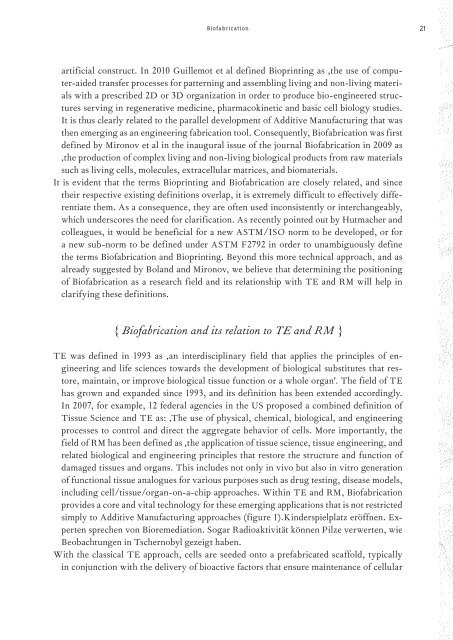Logbuch_17x24Druck_einzelseiten
You also want an ePaper? Increase the reach of your titles
YUMPU automatically turns print PDFs into web optimized ePapers that Google loves.
Biofabrication<br />
21<br />
artificial construct. In 2010 Guillemot et al defined Bioprinting as ‚the use of computer-aided<br />
transfer processes for patterning and assembling living and non-living materials<br />
with a prescribed 2D or 3D organization in order to produce bio-engineered structures<br />
serving in regenerative medicine, pharmacokinetic and basic cell biology studies.<br />
It is thus clearly related to the parallel development of Additive Manufacturing that was<br />
then emerging as an engineering fabrication tool. Consequently, Biofabrication was first<br />
defined by Mironov et al in the inaugural issue of the journal Biofabrication in 2009 as<br />
‚the production of complex living and non-living biological products from raw materials<br />
such as living cells, molecules, extracellular matrices, and biomaterials.<br />
It is evident that the terms Bioprinting and Biofabrication are closely related, and since<br />
their respective existing definitions overlap, it is extremely difficult to effectively differentiate<br />
them. As a consequence, they are often used inconsistently or interchangeably,<br />
which underscores the need for clarification. As recently pointed out by Hutmacher and<br />
colleagues, it would be beneficial for a new ASTM/ISO norm to be developed, or for<br />
a new sub-norm to be defined under ASTM F2792 in order to unambiguously define<br />
the terms Biofabrication and Bioprinting. Beyond this more technical approach, and as<br />
already suggested by Boland and Mironov, we believe that determining the positioning<br />
of Biofabrication as a research field and its relationship with TE and RM will help in<br />
clarifying these definitions.<br />
{ Biofabrication and its relation to TE and RM }<br />
TE was defined in 1993 as ‚an interdisciplinary field that applies the principles of engineering<br />
and life sciences towards the development of biological substitutes that restore,<br />
maintain, or improve biological tissue function or a whole organ‘. The field of TE<br />
has grown and expanded since 1993, and its definition has been extended accordingly.<br />
In 2007, for example, 12 federal agencies in the US proposed a combined definition of<br />
Tissue Science and TE as: ‚The use of physical, chemical, biological, and engineering<br />
processes to control and direct the aggregate behavior of cells. More importantly, the<br />
field of RM has been defined as ‚the application of tissue science, tissue engineering, and<br />
related biological and engineering principles that restore the structure and function of<br />
damaged tissues and organs. This includes not only in vivo but also in vitro generation<br />
of functional tissue analogues for various purposes such as drug testing, disease models,<br />
including cell/tissue/organ-on-a-chip approaches. Within TE and RM, Biofabrication<br />
provides a core and vital technology for these emerging applications that is not restricted<br />
simply to Additive Manufacturing approaches (figure 1).Kinderspielplatz eröffnen. Experten<br />
sprechen von Bioremediation. Sogar Radioaktivität können Pilze verwerten, wie<br />
Beobachtungen in Tschernobyl gezeigt haben.<br />
With the classical TE approach, cells are seeded onto a prefabricated scaffold, typically<br />
in conjunction with the delivery of bioactive factors that ensure maintenance of cellular


